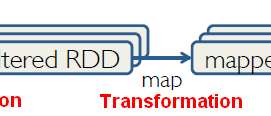About
Spark permits to reduce a data set through:
Articles Related
Reduce
The reduce function of the map reduce framework
reduce([[..:function|func]])
Reduce is a spark action that aggregates a data set (RDD) element using a function.
That function takes two arguments and returns one.
The function must be (Function | Operator | Map | Mapping | Transformation | Method | Rule | Task | Subroutine) enabled.
reduce can return a single value such as an int.
Reduce a List
rdd = sc.parallelize([1, 2, 3])
rdd.reduce(lambda a, b: a * b)
Value: 6
Reduce a List of Tuple
Numeric value
reduceByKey(function|func) return a new distributed dataset of (K, V) pairs where the values for each key are aggregated using the given reduce function func, which must be of type (V,V) → V
rdd = sc.parallelize([(1,2), (3,4), (3,6)])
rdd.reduceByKey(lambda a, b: a + b)
RDD: [(1,2), (3,4), (3,6)] → [(1,2), (3,10)]
If the value is a string, you can use the groupByKey() to reduce it. See below
String value
groupByKey() return a new dataset of (K, Iterable
) pairs]] Key-Value Transformations
rdd2 = sc.parallelize([(1,'a'), (2,'c'), (1,'b')])
rdd2.groupByKey()
RDD: [(1,'a'), (1,'b'), (2,'c')] -> [(1,['a','b']), (2,['c'])]
Be careful using groupByKey() as it can cause a lot of data movement across the network and create large Iterables at workers
Imagine you have an RDD where you have 1 million pairs that have the key 1. All of the values will have to fit in a single worker if you use group by key. So instead of a group by key, consider using reduced by key or a different key value transformation.
- count()
- countApprox
- countApproxDistinct
- sum()
- max
- mean
- meanApprox
- min
